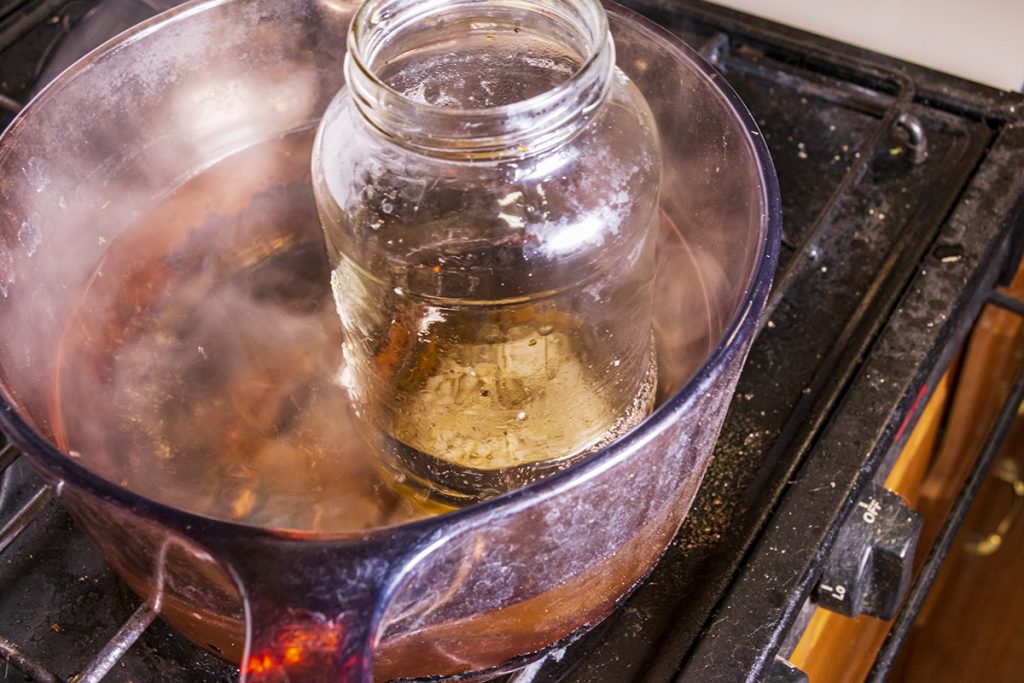Welcome, plantain enthusiasts! Are you ready to hear about the latest wonder product taking the natural healing world by storm? Look no further than plantain healing balm! This magical ointment is made from the humble plantain leaf, a weed found in many backyards and fields. But don’t be fooled by its common appearance – this herb has been used for centuries to soothe and heal all manner of skin issues, from bug bites to eczema. In this article, we’ll explore the many benefits of plantain healing balm and how you can make your own at home. So sit back, relax, and get ready to be amazed by the power of this underappreciated herb!
This plantain healing balm is great for treating minor skin wounds or irritations. If you read the article on wild plantain and all the healing benefits of this common “weed” then you know its many benefits for your skin.
In this article, I’m going to show you how to make a healing plantain balm/salve that is not only good for your skin but can tame those “ouchies” that we can get when we spend time in the outdoors during the warmer months. Bug bites, minor cuts and scrapes, and other minor skin problems can be helped immensely by using this simple recipe to create a natural healing balm.
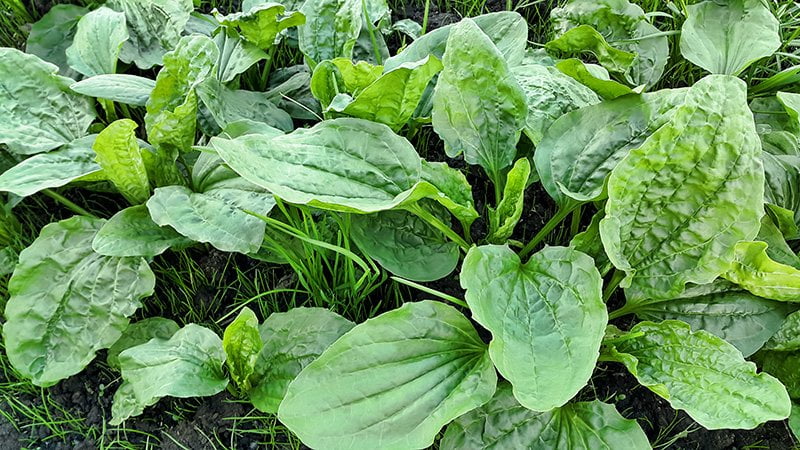
The most useful benefit of plantain for the skin is that it contains a substance called Allantoin. This substance is powerful for soothing the skin. It also has properties that help your skin regenerate and heal. The leaves of plantain also contain substances that are anti-inflammatory and antimicrobial. These benefits can help to tame the itchiness that occurs with bug bites, soothe inflamed skin, promote healing, and help prevent infection in minor wounds. This should be plenty of reason to learn to identify and use this natural and free alternative to commercial preparations. Oh, did I also mention it’s FREE!?
Besides being plentiful in most of the U.S., it grows extremely well anywhere the soil is disturbed by humans. That makes it easy for even city dwellers to find and use. So let’s get started making your first batch of this amazing plantain healing balm.
Gather Supplies
You’ll want to make sure you have the following supplies on hand before you harvest your plantain leaves:
- Quart Glass Jars
- Food Processor or Blender (Optional)
- Crock-Pot (To Heat The Oil)
- Small Jars or Tins (For Storing Your Balm. Buy Here)
- Bees Wax Pellets (Buy Them Here)
- Shea Butter (Buy Here)
- Carrier Oil (Your Choice)
- Measuring Cup
- Reusable Coffee Filter (Optional- Useful for pressing the oil out of the leaves when you strain the oil.)
- Cooking Thermometer (To Monitor The Temperature Of The Oil)
- Essential Oils (Optional)
Now that we have all our supplies let’s go harvest some plantain.
Harvesting Wild Plantain
The first step in using any wild medicinal plant is to learn to identify it and sustainably harvest it. Plantain is easy to identify for those who are new to gathering wild plants due to its 5-7 veins in the leaf which run down the length of the leaf, as in the photo above. When harvesting be sure and leave some plants to go to seed, so you will have a continuing supply in the future. Also, take only a few leaves from each plant, so the plant can survive and continue to grow additional leaves.
Below is a photo of the leaves I gathered in just a few minutes around the Lost In The Ozarks headquarters.

To gather the leaves take a small pair of scissors and snip off the leaf from the stem at the base of the leaf. Don’t worry about the size for use in making the balm. Although the leaves get tough and fibrous as they get bigger, that doesn’t matter for our purposes. You only want the young leaves for edible purposes, but when using them in an oil infusion the bigger leaves will most likely contain more of the healing properties.
Once you get ready to process the leaves the first step is to wash them to remove any small insects, dirt, or other things that we don’t want in our infused oil. Then you will need to lay them out on a towel to dry as shown below.
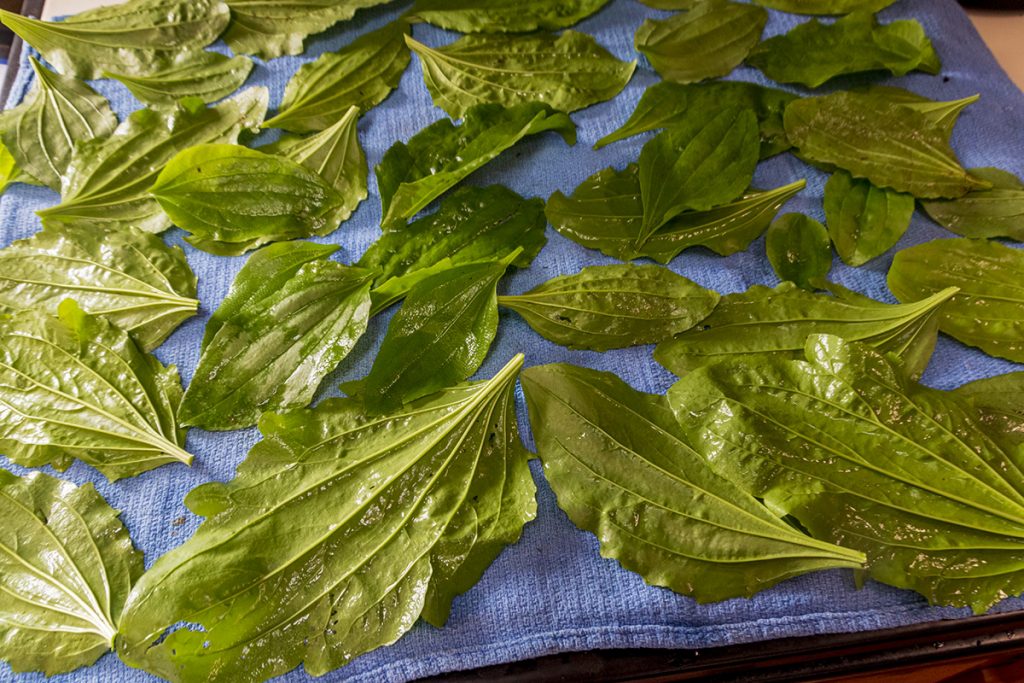
The reason you want to let them dry is that you don’t want to add additional moisture to your oil infusion. Water can promote the growth of mold in your stored finished balm. We want to remove as much as possible before processing the leaves.
Making Plantain Infused Oil
Now we are ready to start infusing our oil to extract the goodness from the plantain leaves. Once the leaves are dry you want to use a food processor or kitchen blender to gently shred the leaves. Just pulse whichever one you are using a few times and then stir the leaves, so they all get processed. Optionally, you can simply tear the leaves into small pieces, but I find using one of the appliances mentioned makes the job much easier. But if you don’t have either one of them don’t let that stop you.
Once the leaves are processed transfer them to a quart glass jar. I generally re-purpose the jars that I buy pasta sauce in. They work great, and again, they are free instead of going out and buying canning jars. Remember, the purpose of wildcrafting your own products for use at home is to make use of natural sources and do it economically.
Once you have transferred the processed leaves to your glass jar you will then need to add a carrier oil such as olive, almond, jojoba, grape seed, or other oil of your choice. For more on carrier oils, you can read this article. You can purchase carrier oils here.
Below are the leaves processed and covered with a carrier oil. You want to add just enough carrier oil to cover the leaves.

Now we need to cover the jar to prevent dust or mold spores from getting into the oil while we are gently heating the mixture. I use a coffee filter and use old bread ties to keep the filter secured on the jar. You can also use a rubber band over the coffee filter and around the mouth of the jar. Using a coffee filter will allow water to evaporate from the oil should any find its way into your infusion.
Now we are ready to place the jar in our crockpot and heat the mixture on low heat for 24-48 hours. I prefer to leave mine for 48 hours to get the most out of my infusion. You’ll want to keep the temperature of the oil between 120-140 degrees F.
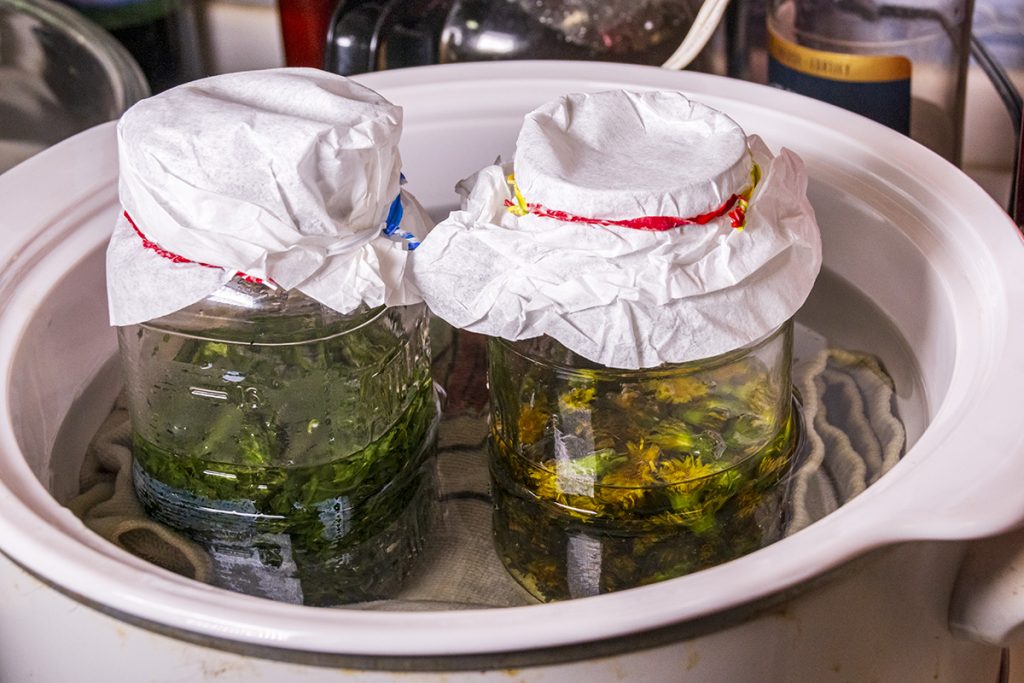
As you can see from the above photo I made both plantain and dandelion oil infusions at the same time.
Place a hand towel in the bottom of the crockpot, place your jars on top of the towel, and fill with warm water to cover the jars about halfway. If the water level gets low carefully add water back up to the halfway point of the jars. After 24-48 hours your oil is ready to prepare the balm.
Note- You can do this the old-fashioned way and simply prepare your jars and then set them in a sunny window for 4-6 weeks, stirring them occasionally. I simply don’t have that kind of patience.
Once the oil is finished use a fine mesh to strain the oil. I use a reusable fine mesh coffee filter to strain the oil. Then I can press the leaves to extract as much of the oil as possible so little if any goes to waste.
However you decide to infuse your oil, the finished oil will look like this.
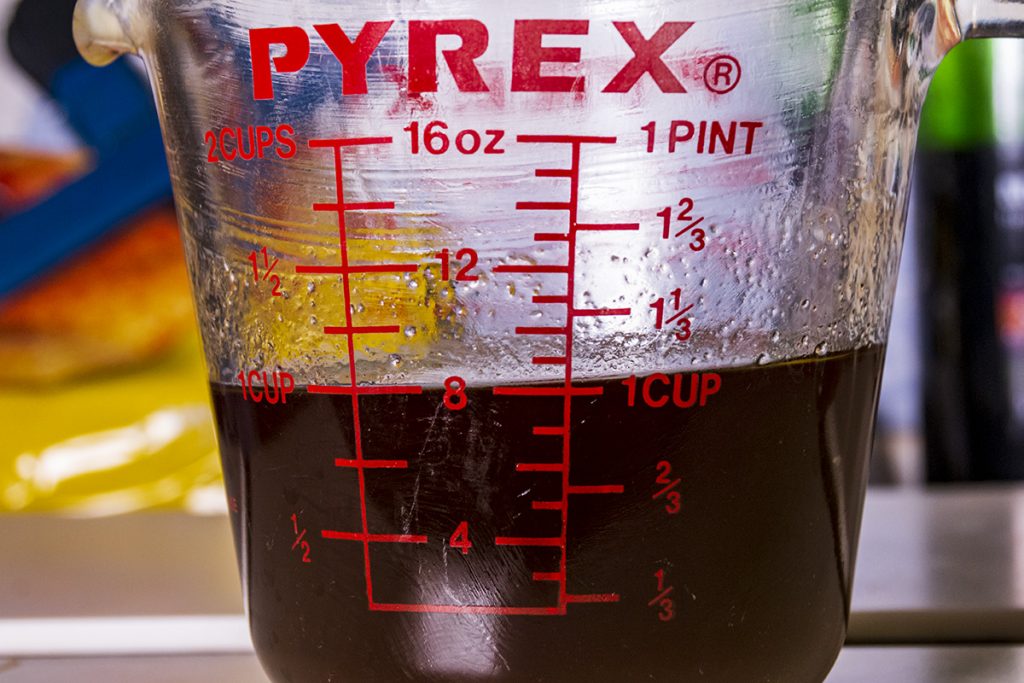
Preparing Plantain Healing Skin Balm
Now we are ready to prepare and bottle our healing skin balm.
The next step is to use a double boiler to melt 2 tablespoons each of beeswax and shea butter. Shea butter is another wonderful plant substance that comes from Africa. It is used in various skin care products and is wonderful for your skin.
Gently heat the beeswax and shea butter until they are liquid, stirring frequently. I use this time to get my jars ready. This recipe will fill 3 of the 8-ounce jars, which for me is about a 1 year’s supply of Plantain Balm. Once the shea butter and beeswax are dissolved carefully stir the warm mixture into your infused plantain oil and stir vigorously to mix well.
Let the mixture cool slightly but not so cool that it begins to harden. I add essential oils at this point and mix them in before bottling. I add 25 drops each of lavender and chamomile essential oils. These soothing and calming essential oils add additional benefits for your skin to the finished product.
Once all the ingredients are mixed pour the mixture into your storage jars and let cool. The mixture will harden as it cools. I prefer to place mine in the refrigerator. I store them there to prolong the useful life of the balm and to prevent mold from growing in them just in case any moisture remains in the mixture.
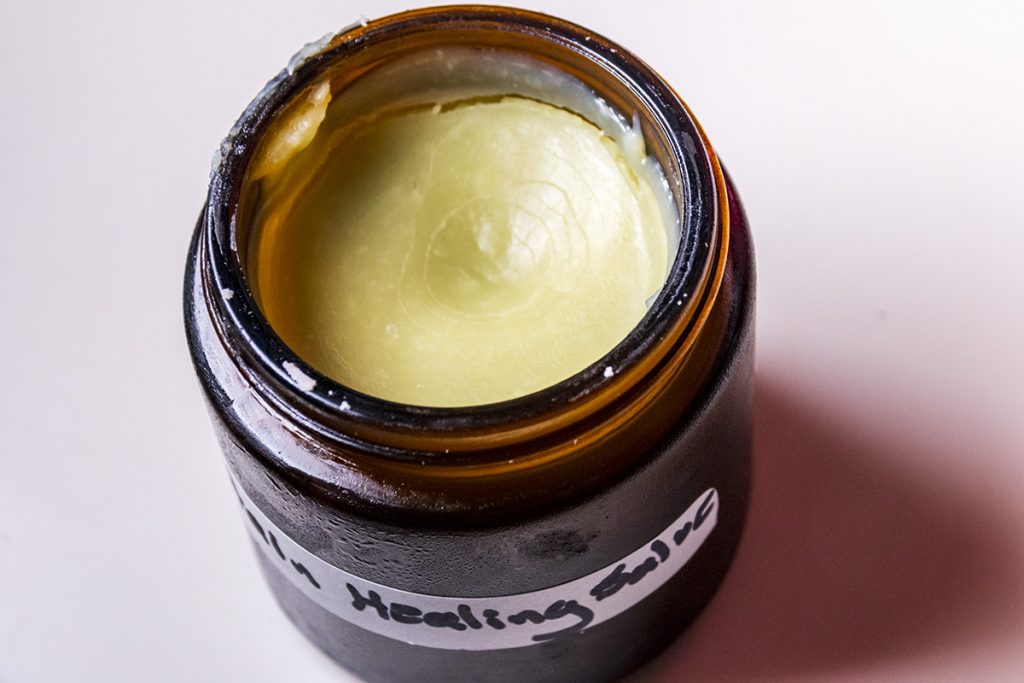
Now you can reach for your plantain healing balm anytime you need it. It is great for bug bites, itchy rashes, sunburn, minor cuts and scrapes, acne, as a gentle skin-loving face mask, diaper rash treatment, dry elbows and feet, and other bothersome skin conditions.
Note that this balm and the infused oil are for external use only. Do not ingest the oil or the balm. If you have a condition that does not respond to your treatment or it gets worse, seek professional medical treatment.
For more information about other wild medicinal plants and essential oils, you can visit our list of articles.
If you don’t fancy creating your own healing balm we offer it for sale at Redeeming the Thyme Farmstand in Lead Hill, AR for our local customers. Stop by and pick up a jar today, and tell Alex we sent you!
Disclaimer: This article should not be construed as medical advice. The health information in this article is not intended to assess, diagnose, prescribe, or promise a cure for any medical condition. Consult with your health care professional before considering any natural supplement or plant remedy for your health and wellness. We assume no liability for the use or misuse of the material presented above. Always consult with a medical professional before changing your diet, or using manufactured or natural medications.
FAQs:
Q: What is plantain balm good for?
A: Plantain balm is good for soothing and healing various skin issues, such as insect bites, rashes, burns, and cuts.
Q: How do you use plantain to heal wounds?
A: To use plantain for wound healing, you can apply the crushed or chewed plantain leaves directly to the affected area, or use a plantain-infused oil or salve.
Q: What is plantain leaf salve good for?
A: Plantain leaf salve is good for relieving skin irritation, inflammation, and discomfort, as well as promoting wound healing and preventing infection.
Q: Can you use plantain to draw out an infection?
A: Yes, plantain can help draw out infection from wounds and boils when used topically, due to its anti-inflammatory and antibacterial properties.
Q: Can plantain leaf cure infection?
A: While plantain leaf has antimicrobial properties and can help prevent and treat infections, it should not be used as a sole treatment for serious infections. Consult a healthcare provider for proper diagnosis and treatment.
Q: What is the common name for plantain leaf?
A: The common name for plantain leaf is “common plantain” or “broadleaf plantain.” It should not be confused with the starchy banana-like fruit also called “plantain.”
Q: What does plantain leaf cure in the body?
A: Plantain leaf can have various benefits for the body, such as reducing inflammation, promoting wound healing, improving digestion, and soothing respiratory issues.
Q: How do you use plantain for infection?
A: To use plantain for infection, you can apply crushed or chewed plantain leaves or a plantain-infused oil or salve to the affected area. However, it is important to seek medical attention for serious infections.
Q: Is plantain leaf good for the skin?
A: Yes, plantain leaf can be good for the skin, as it can help soothe and heal various skin issues, such as insect bites, rashes, and burns.
Q: How do you apply plantain to your skin?
A: To apply plantain to your skin, you can crush or chew fresh plantain leaves and apply them directly to the affected area, or use a plantain-infused oil or salve.
Q: Is plantain good for the face?
A: Yes, plantain can be good for the face, as it can help soothe and heal various skin issues, such as acne, eczema, and inflammation. However, it is important to do a patch test before applying plantain to your face, as some people may be allergic to it.
